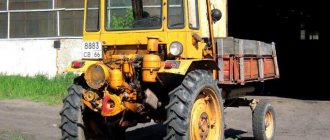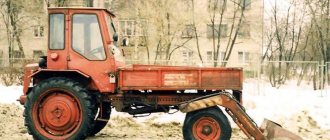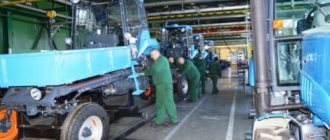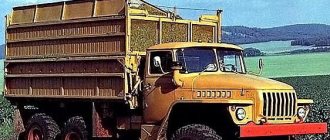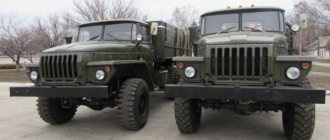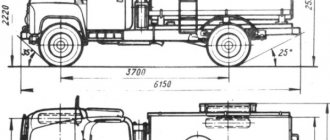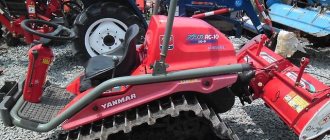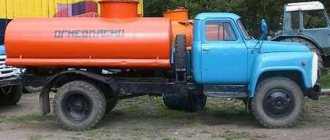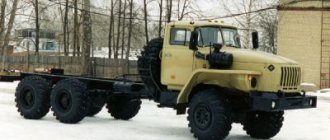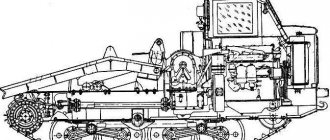VTZ-30 SSh is a Russian-made multifunctional self-propelled chassis. This is a very unusual tractor with a front body. This non-standard layout was positively received by users, because such innovative solutions are rarely found on the tractor market. But in fact, the machine is very simple in design, and this is its main advantage. The equipment is the successor to the popular T-16 model with exactly the same body layout. Of course, the VTZ-30 SSh is much better than its predecessor in many respects. At the same time, the range of capabilities of the machine has expanded slightly - thanks to the support of more attachment options.
Article navigation
- 1 Scope of application
- 2 Technical specifications
- 3 Features of device and operation
- 4 Photos
- 5 Videos
- 6 Price
- 7 Reviews
Machine design
Structurally, the machine is a motorized vehicle built using tractor components. The T 16 self-propelled chassis is designed with a rear-engine design, with the driver's seat located above the power unit. A short tubular frame is attached to the engine, which serves as the basis for installing an onboard body or various specialized equipment. The photograph shows a typical T 16 chassis in actual use.
Thanks to this arrangement, the driver of the chassis has a good overview of the cultivated area and mounted units. The center of gravity of the machine is shifted to the axis of the driving rear wheels, which ensures reliable grip on the surface. To drive various auxiliary devices, the gearbox has up to three mounting points for power take-offs. A drive pulley can be used to drive stationary installations. In addition, the chassis can be equipped with a hydraulic system.
The chassis could be equipped with a dump platform, agricultural or municipal equipment, and installations for road repair and maintenance. The maximum load capacity of the chassis is up to one ton. It should be noted that the machine was originally created with an eye to use in agriculture. The chassis ground clearance increased to 56 cm allows for the processing of grape crops.
The T 16 self-propelled tractor chassis has become one of the most popular in the world - in total more than 600 thousand copies of the vehicle were produced. Due to its characteristic appearance, the chassis had common nicknames in the USSR: “Drapunets” or “Beggar”. The general view of the car is shown in the photograph.
Tractor Vladimirets: T 25, T30, 2048, model range
Tractors from the Vladimir Tractor Plant are in demand not only in the Russian Federation, but also abroad.
The Vladimirets tractor is a reliable machine adapted to harsh operating conditions. During production, the plant produced a large number of different models and their modifications.
Depending on the modification, the machines of the Vladimir plant are used to perform various tasks.
Tractor Vladimirets 2048
The machine is designed to perform work in agriculture. The wheel arrangement of the vehicle is 4x4, thanks to which the tractor can move off-road.
The model has a frame design. The power unit is located in the front of the frame. The machine is controlled by turning the wheels of the front axle.
INTERESTING: Depending on additional equipment, the 2048 tractor is used in agriculture, industry, public utilities, etc.
The Vladimirets 2048 tractor is equipped with a three-cylinder diesel engine. Motor specifications:
- Power unit brand – d-130;
- Number of working cylinders – 3;
- The arrangement of the cylinders is vertical, in-line;
- Power plant volume – 3120 cm3;
- Maximum power – 45 hp;
- Diesel fuel consumption – 241 g/kW per hour.
Low fuel consumption allows you to use the machine for a long time without refueling.
The power unit operates with a manual gearbox. It has 8 forward and 6 reverse gears. Shifting is possible after disengaging the clutch. The clutch is double-disc, dry, and is constantly in the on position. Switching off is carried out by pressing the pedal at the operator's station.
ATTENTION: To avoid jerking when starting to move, the clutch is equipped with two discs with friction linings.
Dimensional mass parameters of the model:
- Length with towbar – 3.46 meters;
- Mirror width – 1675 mm;
- Height – 2.6 m;
- Distance between axles (longitudinal base) – 2.45 m;
- The track along the centers of the front axle wheels is adjustable from 1322 to 1533 mm;
- Rear wheel track – adjustable from 1210 to 1484 mm;
- The weight of the machine without additional equipment is 2750 kilograms.
- Agriculture. Plows, soil cultivators, harrows and other soil cultivation equipment are used. The machine is widely used in farms with limited space;
- Utility services. The tractor is equipped with a front blade, brushes, etc. This allows you to clean the asphalt surface from debris and snow;
- Construction. The machine is used for transporting construction materials;
- Animal husbandry. Using a trailer allows you to transport feed and other cargo.
REFERENCE: There is a modification of the “2048A” tractor, it has similar technical characteristics. A distinctive feature of the 2048A is its lighter weight.
Tractor Vladimirets 2032
The machine is used to perform light work in areas with limited space. Small dimensions allow the model to be used in gardening, vineyards, livestock farms, etc.
Skidder – Model range
.
Depending on additional equipment, the machine can be used in the following areas:
The Vladimir tractor 2032 is available in two modifications. The all-wheel drive version is designated 2032A. Depending on the version, the tractor has the following dimensions and weight:
- The length of the machine with front and rear tow hitch is from 3180 to 3320 mm;
- Width along the outer edges of the wheels – from 1560 to 1660 mm;
- Height from the covering to the edge of the exhaust pipe – from 2540 to 2570 mm;
- Base (distance between axles) – 1775 mm;
- Ground clearance under the rear axle – 345 mm;
- The track at the wheel centers is adjustable;
- Tractor weight is from 2000 to 2390 kilograms.
The model's power plant has two working cylinders. The motor is air-cooled. The maximum engine power is 30 horsepower. This is enough to perform a wide range of light work.
IMPORTANT: Modification 2032A is equipped with two drive axles. The rear axle works constantly, the front axle is connected. The bridges are equipped with wheels with all-terrain tires.
Tractor Vladimirets T 30
The model has a semi-frame design. The engine is located in the front part of the T 30 tractor. In the basic configuration, the machine is equipped with a two-cylinder power unit. The engine is air-cooled and runs on diesel fuel. The engine lubrication system is combined. The oil pressure in the system is provided by a gear-type pump.
Wheel formula of the tractor Vladimirets T 30 4x2. The front beam is fixed to the tractor frame. While driving, the front beam can follow uneven terrain, regardless of the position of the rear axle. The front axle is equipped with rotating wheel mechanisms. They are necessary to control the tractor.
Minitractor Rusich T-12, 15, 18, 21. Review of models
A metal cabin is installed at the rear of the tractor. It is equipped with a heater and ventilation system. The operator's seat is installed in the cab. On the front wall of the cabin there is a panel of control and measuring instruments. They allow the driver to monitor the operation of mechanisms and components.
The manufacturer equipped the Vladimir T 30 tractor with a separate brake system. This allows you to turn almost in one place. The brakes are controlled from the operator's cabin by two pedals. The brake mechanisms are installed on the rear axle.
During the production of the tractor based on the T 30 tractor, the following modifications were produced:
Model VTZ 30-SSH
The car has a rear-mounted power unit. The metal cabin is located in the rear. In front of the frame there is a metal body with folding sides. This allows the machine to be used for transporting various cargoes.
The body of the model is equipped with a lifting system. The body is tipped using a power hydraulic cylinder. The platform is controlled remotely from the operator's cabin.
IMPORTANT: Not only the body, but also other specialized equipment is installed on the platform.
The car's cabin is metal. The cab contains an adjustable operator's seat. This allows you to select parameters for the operator. The operator's seat is sprung. This design reduces vibrations transmitted from the chassis while driving.
Next to the tractor driver’s seat there are:
- Steering wheel;
- Hydraulic system control levers;
- Instrumentation unit;
- Switch panel;
- Gear shift lever.
The floor contains clutch and accelerator pedals and two pedals for a separate brake system.
The model has a manual gearbox. It allows you to change 6 gears forward and 6 in reverse. The gearbox is rigidly mounted on the power unit. Torque is transmitted to the input shaft using a dry-type double-disc clutch. Two discs with friction linings allow you to move away smoothly when the load on the drive axle is high.
Tractor T-100 – Technical characteristics
The manufacturer installed a two-cylinder diesel engine with a volume of 2080 cm3 on the VTZ 30SSH. The cylinders are vertical. This allows you to reduce the level of vibration during operation. The maximum power of the power plant is 30 hp. The engine has low fuel consumption and is unpretentious to operating conditions. You can also read about the Kubota Minitractor: Model range of tractors.
Tractor Vladimirets T 25
The model was produced at the Vladimir Tractor Plant from 1972 to 2000. The T 25 has a semi-frame design with a front-mounted power unit and rear-wheel drive.
Tractors from the Vladimir plant T 25 were equipped with a two-cylinder power plant. Maximum engine power is 25 horsepower. The motor is mounted on elastic cushions, which helps smooth out vibrations transmitted to the cabin during operation.
The power unit is started from a 12-volt electric starter. The starter's power source is a rechargeable battery. The starter is included in the electrical wiring according to a single-wire circuit. The negative contact is the starter housing.
REFERENCE: The engine is easy to maintain, economical and unpretentious to the quality of diesel fuel. Any malfunctions that arise can be eliminated in the field.
Dimensions T 25:
The tractor cabin is equipped with a heater, this allows the machine to be used at low ambient temperatures. For safe driving on public roads, the T 25 has light and sound alarms.
From the above it follows that Vladimir tractors, the model range of which is given above, are multifunctional machines. Universal attachments and high technical characteristics allow them to be used in various fields of activity.
Engine and components
The chassis' power unit was a four-stroke, two-cylinder, air-cooled diesel engine. The engine design implemented the principle of mixture formation in the prechamber. The prechamber was made as a separate part, pressed into the block head. The size of the prechamber was slightly more than a third of the total volume of the combustion chamber.
The main part of the engine was a cast-iron crankcase, to the front of which was attached an aluminum housing for the camshaft drive gears. The camshaft was mounted on ball bearings, which is a non-standard solution. The removable outer housing cover had a filler neck for oil and a crankcase ventilation breather. At the front of the engine there was a belt drive for the generator and fan. The drive was carried out from a pulley at the front end of the diesel crankshaft. On the opposite side of the engine there was a flywheel housing to which the electric starter was attached. The general view of the engine is shown in the photographs.
The crankcase had two holes for installing cylinders, four for valve drive rod guides, and eight for cylinder mounting studs. The cast iron cylinder had developed cooling fins. The inner surface of the cylinder was processed accordingly and served as a working surface. Each cylinder had an individual head with cooling fins. Early versions of the head could be made of cast iron. Cast iron parts in production were quickly replaced with aluminum ones. Thanks to the replacement of the material, it was possible to optimize combustion processes and improve the fuel efficiency of the engine. Each set of head and cylinder was attached to the crankcase with four studs.
The engine was cooled by an air flow from an axial fan, directed using a casing and deflectors. On the early model of the D 16 engine, the air flow was directed only by deflectors. The flow intensity could be adjusted by a special throttle valve at the entrance to the air intake. A double-piston pump for fuel supply and two oil filters - fine and coarse - were installed externally on the crankcase. The pump was standardly equipped with a speed regulator. The fuel supply is located in the tank under the driver's seat.
Early versions
The KhZTSSh plant mastered the production of the first chassis model under the designation T 16 in 1961. In design, the vehicle was a significantly modernized version of the DSS 14. The first version was produced in small quantities, and in just 6 years a little more than 63 thousand vehicles were assembled. Photo of DSH 14 below (from the archive of Peter Shikhaleev, 1952).
One of the differences between the early chassis is the D 16 diesel with a power of about 16 hp. The gearbox had two power take-off shafts - the main and synchronous ones. Externally, the chassis was distinguished by the absence of a driver's cabin; there was only a light awning on removable arches.
Tractor VTZ-30 SSH technical characteristics, device features and price
VTZ-30 SSh is a Russian-made multifunctional self-propelled chassis. This is a very unusual tractor with a front body. This non-standard layout was positively received by users, because such innovative solutions are rarely found on the tractor market. But in fact, the machine is very simple in design, and this is its main advantage. The equipment is the successor to the popular T-16 model with exactly the same body layout. Of course, the VTZ-30 SSh is much better than its predecessor in many respects. At the same time, the range of capabilities of the machine has expanded slightly - thanks to the support of more attachment options.
Article navigation
First modernization
One of the main disadvantages of the early version of the self-propelled chassis was the insufficient engine power. Therefore, in 1967, the car was modernized by installing a 25-horsepower diesel engine. Due to this, it was possible to increase the maximum speed of the vehicle and improve cross-country ability. The new model could be equipped with a closed cabin with two doors. The roof of the cabin was made of canvas.
The modernized version of the chassis was designated T 16M and remained on the production line until 1995. During this time, the plant assembled 470 thousand copies of the car. General view of the T 16M chassis in the photo.
Second modernization
In the mid-80s, the chassis received an all-metal driver's cabin and a new D 21A diesel engine with a power of 25 hp. A comprehensive modification of the machine components was carried out, which made it possible to increase the service life and reduce the labor intensity of maintenance. It was on this model that three power take-off shafts were introduced on the gearbox. This version was designated T 16MG and was produced in parallel with the T 16M until 1995. The photo shows a typical T 16MG.
The new car had much better data. A more flexible diesel engine made it possible to reduce the minimum speed of the car to 1.6 km/h using a lower gear. Thanks to this, the chassis has become popular for road and agricultural work. On the T 16M, the ability to tip the body was introduced, driven by a hydraulic cylinder.
High power chassis
In the 60s, the head design bureau for combines and self-propelled chassis created several machine designs using components from more powerful tractors. The chassis was intended for the installation of various combine superstructures.
One of these products was the SSh 75 “Taganrozhets” unit, the production of which began in 1965 at the Taganrog plant. Structurally, the machine was a frame on wheels, on which the engine, transmission components, cabin and hydraulic drives became. The SSh 75 was equipped with a four-cylinder 75-horsepower SMD 14B diesel engine with liquid cooling. One of the surviving Taganrozhets is shown in the photograph.
The production of agricultural self-propelled chassis continued until the early 70s; in total, almost 21 thousand vehicles were produced. Various attachments for completing machines were produced at the same plant. Depending on the type of hitch, the cabin could stand at different points on the chassis. Mounting points were centrally above the front axle or to the side above either drive wheel. For example, when installing the NK 4 combine harvester, the cabin stood on the side, and when installing the NS 4 dump body, it was in the center, above the steered wheels.
Scope of application
The VTZ-30SSh tractor can be used for loading and unloading operations, as well as for transporting various types of cargo, including bulk containers and concrete structures. The equipment is in demand in agriculture, as well as among public utilities. The machine has proven itself excellent in snow removal operations, as well as in cleaning sand, soil, leaves, mown grass, loosened haylage, hay, etc. In general, the VTZ-30SSh tractor copes with its main task - transporting various cargo containers. If necessary, you can install certain attachments, and thereby significantly expand the functionality of the machine. Based on the tractor of the same name, forklifts are produced, as well as vacuum sidewalk sweepers and self-unloading machines. Among the list of work performed available for the VTZ-30SSH tractor, we note attachments that allow you to cope with certain tasks:
- Cleaning brush
- Blade with rubber blade
- Front mounted brush/scraper
- Plow-scoop unit
- High pressure equipment for pollination and spraying
- Distributor of liquid and bulk reagents
- Snow blower of milling-rotary type
- Pumping unit for pumping out water
- Combined harvesting machine
- Mobile repair workshop
- Attachments for highways (road markings)
- Excavator equipment
- Segment type mower
Modern options
Currently, the tractor plant in Vladimir produces the VTZ 30SSh chassis - a universal vehicle for performing special work in various fields of the economy. Upon request, the machine can be equipped with various equipment to expand the range of applications. Thanks to the high ground clearance, the chassis overcomes water obstacles with a depth of up to 0.5 meters.
The car first appeared in 1998. The chassis design is based on the 2032 tractor and is very similar to the T 16 chassis. The difference between the VTZ 30SSh is the rear location of the engine and transmission. To increase driver comfort, the cabin has a ventilation and heating system. The flat front and rear windows are equipped with windshield wipers. As standard, the chassis comes with a steel side platform with a length of 2.1 m and a width of almost 1.45 m. The platform has low sides and can accommodate up to 1000 kg of various cargo. Vladimir chassis in the photo below.
The power unit is a 30-horsepower diesel engine D 120, which is a modernized version of the D 21A. The gearbox has six speeds and reverse capability. The speed range is from 5.4 to 24 km/h. The box has only one independent power take-off shaft.
Reviews from owners of "VTZ-30SSh"
Naturally, today there can be no talk of any tens, much less hundreds of thousands of self-propelled chassis units rolling off the factory assembly line. "VTZ-30SSh" is produced in more than modest quantities, since the demand for this equipment is extremely weak. But still he is there.
The few owners of the VTZ-30SSh note that, despite all the changes and modernizations, it remains an extremely simple and unpretentious vehicle, just like the T-16. As one of the owners jokingly put it, “respect to the manufacturers of Russian equipment - they respect ancient traditions. But seriously, the technology is super, there are just a lot of shortcomings, but you can ignore them or redo them yourself.”
Everyone agrees that he is a wonderful assistant in making hay. Working with a mower, both the old KSF-2.1 brand and modern models, is greatly simplified using this equipment. Because you don’t need to “turn your neck”, periodically looking back: everything is visible perfectly. The mower body is rigidly attached to the frame, and lifting and lowering is carried out by lifting the cutting device. And the consumption of diesel fuel, by the way, is encouraging: harvesting hay is very economical with the VTZ-30SSh.
On vegetable plantations, “VTZ-30SSh” is successfully used for hilling and weeding both potatoes and other crops: the working bodies located between the axes are never blown off the row; the entire processing process is right in front of the operator’s eyes). Some people attach a milling cutter to the chassis for cultivating the land instead of a plow. Similar to the one used on walk-behind tractors, but more substantial in size.
In general, the versatility of this technique is one hundred percent. If desired, any household unit can be hung on the VTZ-30SSh frame and successfully used - even a chain saw, even a winch, or even a sprayer. But, of course, few people take advantage of these opportunities.
And the traditional purpose - transportation of goods (especially if there is a self-loader, bulldozer shovel and the like on the chassis) is also, as they say, “nobody has canceled”. Therefore, a number of owners of the VTZ-30SSh do not have any additional attachments, and the chassis is used exclusively as a truck, “on hand,” for various small and medium-sized jobs. All reviews are discreetly laudatory.
